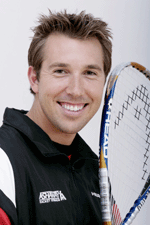|
|

Jack Huczek on Stringing
and Staying Ahead of the Pack
By Steve Crandall
Vice President, Sales & Marketing
Ashaway Racket Strings

From the most dominating junior player in racquetball history, Jack Huczek has propelled himself to the number one spot on the IRT. Known for his hard work ethic and extreme fitness level, Jack will be the man to beat for number one this year. |
We've talked about Jack Huczek's stringing habits before in this column (he uses Ashaway SuperKill® II) , but now that he's become a recognized columnist in his own right (see the "Training with Jack" column), we thought we'd see what advice he might have for others on the subject. We recently caught up with him between classes on the campus of Oakland University where he is busily pursuing his MBA. Not surprisingly, he had several good points to offer.
"The first thing I would say to someone who is trying to figure out what string they should use is that they have to determine what they want out of the string," he said. "Do they want a performance string? Do they want a string that is going to be durable, a string that works a certain way? Figure out exactly what the need is first."
For example, Jack said if you are a chronic string breaker, you would "want a string that is going to wear evenly across the sweet zone of the racket and is going to last for a long time."
And what's a long time? "Well," he said, "it depends mainly on how often they're going to be using the racket. If we're talking about the average recreational player who isn't looking for a high performance string, but wants something economical, and they don't want to restring their rackets every two weeks, I would say a set of strings should last a minimum of a quarter of a year: so four sets a year."
But what about other performance aspects, we asked? Are there specific ways to test one string against another? "For me," said Jack, "string performance is largely a matter of how it feels. Different strings may feel stiffer or more forgiving. The string might have a little more bite, might induce a little more spin on the ball. Everyone swings differently, everyone hits the ball differently, so it really comes down to player preference: you just have to hit with rackets that have different types of string in them."
"For example," Jack continued, "some strings are more abrasive to the touch, and will induce more spin on the ball. If you are a player who maybe puts a lot of spin on the ball, naturally - just by the way you swing - you probably don't want a string that is going to add more spin. Racquetball is not like squash or tennis where you're trying to put spin on the ball. In racquetball, strokes are meant to be flat, so if you have trouble swinging level and hitting the ball flat, you may want to select a smoother string that doesn't produce more spin.
"On the other hand, even though most strokes are flat, there are times - serving or hitting soft shots for example—when you may need a little bite on the ball to control it better. If you are looking for that, then you may want a set of strings with more texture."
The bottom line, said Jack, is to evaluate your style of play to determine what you need from a string, then experiment until you find the one that feels right.
While we had him, we also thought we'd see how he is reacting to being acknowledged as one of the world's top players. How did it feel to be on top, we asked, and now that he has achieved his long-term goal of becoming number one, how does he keep himself motivated?
"Being number one means that the target is now on your back!" he laughed. "The bar gets raised and you have to continually set it higher, because everyone's shooting for you. That can be pretty motivating all by itself!" But then, in a more serious tone, he said, "Once you make it to the top, once you are number one, you have to validate that. Finishing number one in one year is great, a good accomplishment, but then you have to prove it wasn't just a fluke. True greatness stands the test of time. My goal now is to make my legacy great over a long period of time and not just one particular year."
And Jack is setting out to do just that. In addition to his academic work, he has a "pretty healthy tour schedule" planned for the coming season. "I think we have 15 or 16 tier one events scheduled," he said. "My goal is to win as many of them as I can, and then of course, to win the two majors, the US Open and the Pro Nationals."
We wish him the best.
This article previously appeared in Racquetball Magazine.
|